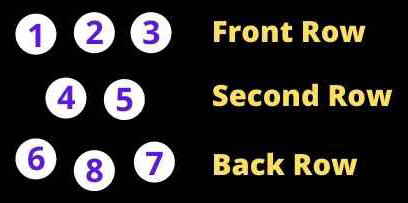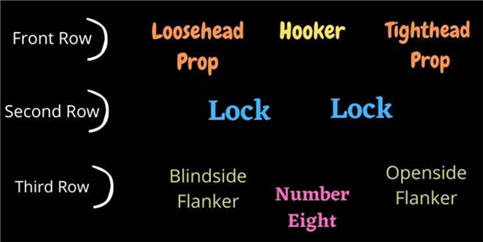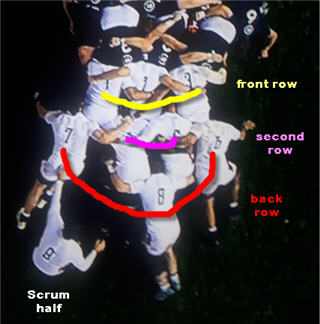The scrum is an iconic passage of play in rugby. The opposing packs of forwards crouch down and lock horns.
Are you wondering why scrum positions always tend to start off looking the same?
And are the positions mandatory or could a coach put a winger into the front row? Read on.
Numbers Of Positions In The Scrum
Scrums in rugby involve the eight forwards from each team scrummaging against each other.
Each team lines its forwards up in three rows. This diagram shows the numbers on the players’ backs.

The front row has the lowest numbers in the team. This traditionally leads to jokes by their teammates about IQ levels (you can find plenty in this great joke book).
The second row wear numbers four and five, while the back row is numbered six to eight.
Names Of Positions In The Scrum
The names we give to forward positions in rugby are largely based on their role in the scrum.
This diagram shows the names at their specific positions. We’ll explain each position in turn.

Hooker
The hooker wears number two and is in the middle of the front row. Their role is to push the ball back to the number eight when the scrum-half feeds it into the gap between the two packs.
In other words, they use a boot to “hook” the ball backward. Hence the name of hooker.
Props In The Scrum
The front row has two prop forwards on either side of the hooker.
Why are they called “props”? Because they prop up the scrum by leaning against the opposition front row.
The prop on the left of the front row wears the number one jersey and is known as the loosehead prop.
His counterpart on the right of the front row wears the number three jersey and is known as the tighthead prop.
I remember this as “tight is right” and “loose is left”.
If you want a more detailed look at this position, check out our in-depth article on the role of props in rugby.
Locks In The Scrum
The second row has two lock forwards.
They are called locks due to their role in locking the scrum into place by connecting or “binding” tightly to the front row.
The pair can be differentiated by referring to the “tighthead lock” and the “loosehead lock”. This simply means which side of the scrum they pack down on.
The tighthead lock packs down behind the tighthead prop. Due to the way pressure occurs in the scrum, often the larger stronger lock in a team will scrummage behind the tighthead prop.
Locks are also known as second rows or second rowers for obvious reasons.
Old-stagers may simplify this even further by referring to the pair as “the row”.
We explain this position in more depth in our article on the role of locks in rugby.
Flankers In The Scrum
Like the front row, there are three players in the back row.
The two players at each end are known as flankers. They get this name because they are on the “flanks” of the scrum.
There are two types of flankers: the blindside flanker and the openside flanker.
The blindside flanker packs down on the side of the scrum that is closest to the touchline.
The openside flanker packs down on the side with the most open space to attack or defend.
We explain this position in more depth in our article on the role of flankers in rugby.
Number 8
The number eight is between the two flankers and packs down with his head between the “behinds” of the two locks.
The role of the number 8 is crucial for getting the ball away from the scrum.
When the hooker heels the ball back to the 8, the player can either pick it up or keep it between his feet until the scrumhalf moves it away from the scrum.
Scrum Positions In Real Life
The perfect diagrams we’ve shown earlier don’t really tell the full story.
I took an overhead snap of a scrum in the 2022 Six Nations match between Scotland and England.
The picture below cuts off the Scottish side of the scrum.
You can see that the England front row is tightly bound to each other and scrummaging straight.
If the front row gets their angles wrong or the scrum wheels so they aren’t straight, the referee will not allow the scrum to complete.
“Not scrummaging straight” is a penalty offense to the opposition.

Do you see the number 7 and number 6? They are not in a neat line with the number eight.
But as long as they keep binding (connecting) to the locks, they are in a valid position i.e. they won’t be penalized.
England is defending in this scrum, and Scotland has put in the ball.
The number seven has swung his body a little further away from the scrum than the number six. He is making sure that he can see a break on the openside by the opposition number eight or scrumhalf.
The Front Row Positions Are Mandatory
There is no rule against the coach putting a tiny winger into the number eight position, or even into the second row.
The problem is that decreasing the power in the scrum will probably lead to it being pushed back or collapsing. This can be a penalty offense.
However, some teams do get clever. Connacht, one of the Irish professional teams, is known for putting their burly international centre into the number eight position.
This lets Bundee Aki pick up the ball and launch an attack.
However, this is a rare tactic.
Why are front row positions mandatory?
Unlike the back row and lock positions, there are strict rules around which players can pack down in the front row.
The front row positions are considered to be specialists and require expertise and training. This is because an inexperienced prop could suffer serious neck or back injuries.
The way this is enforced is that teams must nominate two players in the 22 or 23-player squad who can play in the front row. The list is provided to the referee.
This means that when a prop forward is substituted, only a nominated player can go into the scrum in that position.
What if the team runs out of front rows?
What if all the players who are nominated to be tighthead props get injured during the match?
Because these positions are mandatory, the referee will not allow a normal scrum to take place.
The answer is that “uncontested” scrums take place. The two teams still line up and pack down against each other. But they are not allowed to exert any force.
More About Scrums
Our diagrams showed the standard eight players in the scrum. But scrums don’t always have that number.
Check out our article on how many players are in a rugby scrum. It goes into the minimum and maximum numbers in the laws.
We also look at the frequency of scrums in our article on how many scrums are there in a rugby match.
Did you know that a scrum is awarded to the opposition if a player dawdles too long after calling for a mark? You’ll learn this and more in our article on when scrums happen in rugby.
Sevens rugby
Check out our article on props in sevens rugby.
It has the corresponding diagrams and pictures to show you what you need to know.